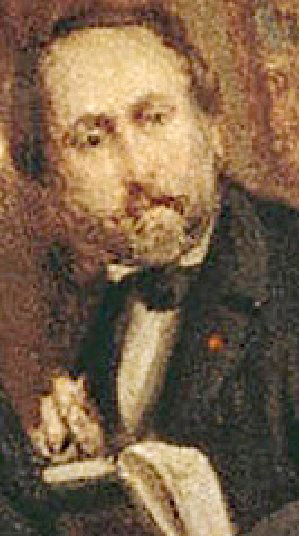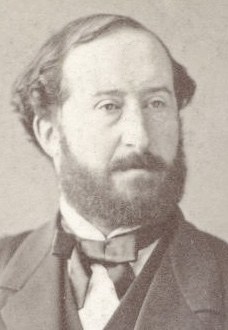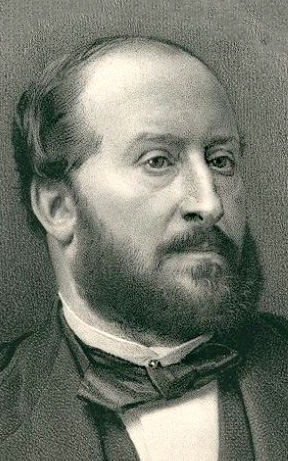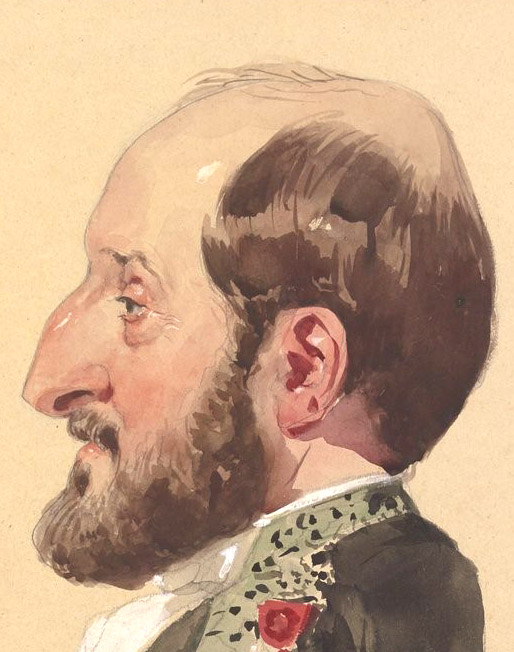Guillaume Victor Émile Augier (1820-1889), poet, dramatist
1st image: Soirée; 2nd: by Heim (1853); 3rd: by Levitsky (c.1860); 4th: by Petit (c.1865); 5th: caricature by Giraud (c.1860).
Émile Augier is considered one of the best comedy writers of the Second Empire, along with Scribe74, and his friend Ponsard70a. His joyful style, reminiscent of Molière, mocked the social habits and prejudices of the bourgeoisie.
Augier was part of the elite group, consisting of Mérimée54, Viollet-le-Duc40a, Viel-Castel43, Delacroix10, de Musset73, and de Nieuwerkerke16, which explains his presence among them at the vendredi-soirées (likely following the success of his comedies in 1852, and 1853), and thus in the painting. The frontal depiction avoids having to display his colossal nose that often was further exaggerated in caricatures. As always, Giraud11 caricatured him in a respectful way.
Raised in a bourgeois family in Valance, Augier started studying law, following in his father’s footsteps. After three years, he preferred the footsteps of his grandfather, Guillaume Pigault, who wrote over twenty comedy plays and novels.
At twenty-four, his romantic drama La Ciguë (1844), inspired by Greek tragedies where the hero (e.g. Socrates) must drink the poison ciguë to commit suicide, became a success. The play reflected on modern society’s use of alcohol, absinthe, and morphine for pleasure.
In 1849, he wrote L’Habit Vert with de Musset, and the comedy Gabrielle, with lead actor Regnier77. In 1851, he wrote librettos for Gounod's70b opera Sapho, with Pauline Viardot (de Musset’s former, and Scheffer's41a unattainable lover) in the main role. Excerpts were later sung by Viardot and Roger04a at many soirées.
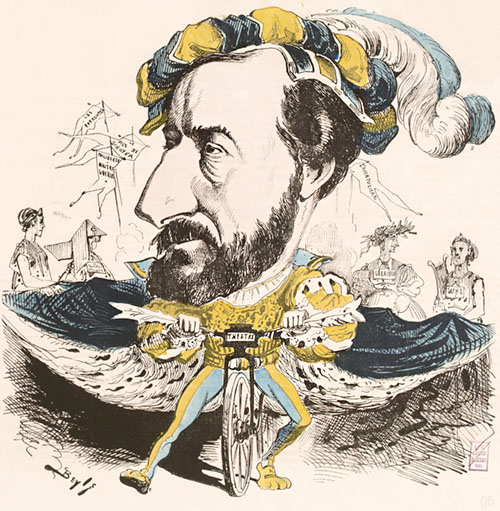
Renowned actress Rachel Félix81 abandoned her tragedy roles for the lead in Augier’s 1852 comedy Diane, with immense success. She subsequently starred in Augier’s comedy L’Aventurière, with Samson80.
His comedy Le Fils de Giboyer (1862, initially named Les Hypocrites), mocking the church and its political influence, caused a national stir. The censors required eighty changes. Eventually, the emperor became involved, indirectly authorizing it, with Princess Mathilde attending the premiere. Later that year, the emperor requested its performance at his Compiègne Palace. While on tour (e.g. Toulouse), it ignited shouting and fights in the audience, with publicity adding to Augier’s fame.
Nevertheless, when asked by a journalist, Augier stated: “I was born in 1820, Sir, since then, nothing has happened to me.”
He became a member of the Académie Française on March 31, 1857, and Grand Officer of the Legion d'Honneur in 1882. His next comedy, Le Fourchambault (1879), was such success that he retired.
Suffering from diabetes, his condition worsened. He had uncorked a bottle of Château-Lafitte when a short revival happened, helping his mood but not his physical condition. He passed away quietly at sixty-nine.
Note: According a recently emerged press article, painter Biard placed himself in a corner, which could be in this position. I dismiss this information as it violates (unwritten) rules of commissioned paintings. More details at my Biard36 page. In absence of convincing evidence, I give preference to writer Augier, who has a good facial match (see Heim’s drawing), and whose fame and many contacts merit (in fact, demand) a place in this illustrious group. Eugène Giraud’s caricature proves his attendance.
